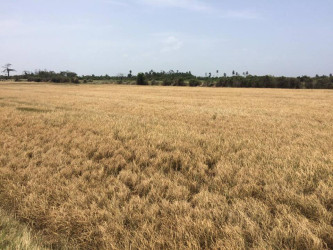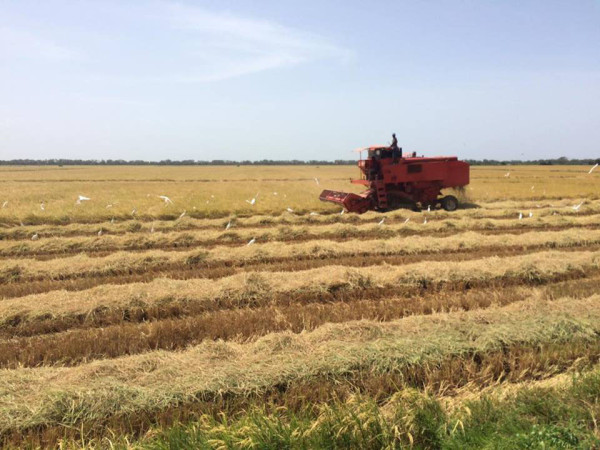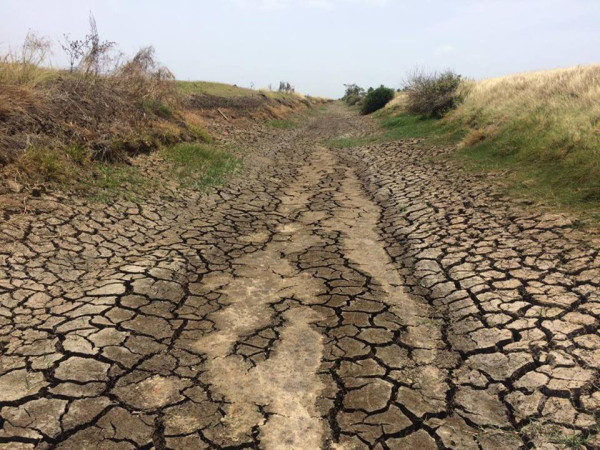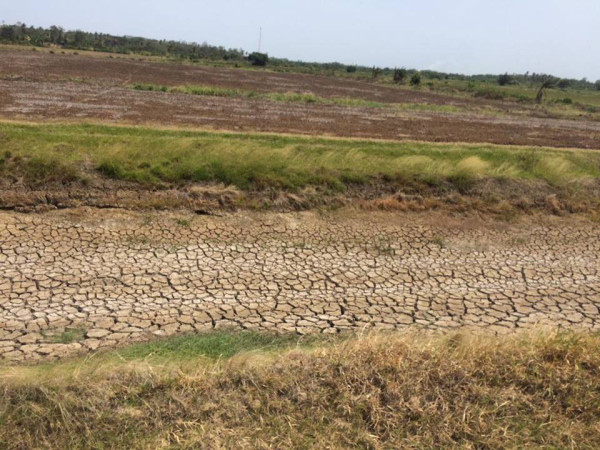Almost 4,000 acres of rice have died so far, owing to El Nino and farmers siphoning off the limited water, and Mahaicony farmers are pleading with the MMA-ADA or other authorities to assist them in their time of dire need.

From Fairfield to Drill, Mahaicony yesterday, as far as the eye could see, the acres and acres of dried up rice looked like wastelands with dried up canals, filled with cracks, running parallel to them.
“You come and you can see fuh yuh self now. Everybody talking about how we getting water and this system working and that system working and look, nothing,” one of the farmers said, pointing at the completely dried creek and dead rice. “Is ya’ll only coming. Nobody else coming and everybody else talking. [General Manager of the MMA-ADA Aubrey] Charles talking about how we getting water but leh I tell you, is not one day he come down here. Not one day I see he come down here in the field to see what going on,” Susankar, a farmer said.
“Watch how many million dollars me lost deh. Is about eight million dollars me spend fuh plant me rice. When I gon get back that money?” Susankar questioned, pointing out that so far he has lost about 250 acres of rice. “It don’t even make sense anymore if we get water next week or even tomorrow cause all around this area dead. They dead and gone,” he added, stating that from the 300 acres he had planted he had estimated to harvest about 12,000 bags of paddy, but will only get about 800 bags now.
“And look at them rice that dead all they needed was about two days of water. Look how they bearing but all they got is wind paddy now. Nothing ain’t gonna come now cause they ain’t get the water,” he said, pointing out that most of the rice that had died could’ve made it to the end of the cycle if the farmers had gotten just two days of water within the last week. He also pointed out that from the 50 acres he managed to save, only about half will be “proper” rice.
“What me gonna do to get back all that money now? Me might gotto go pawn this pick-up [truck], the car, the tractor and all what me got to get money to plant back rice. Like I gotto do things I never do before to get back money,” he said, adding that while most of the farmers are losing rice the millers are still going to underpay them. He said that he had called one of the millers earlier but was not given a price.
“Last year we get about $2,100 for a bag and we might even get the same thing. Calculate that and see if I getting anything significant,” he added.
While most of the farmers would have patrolled at night to ensure there was no unauthorized pumping of water, a gesture which was lauded by Charles, they said they had given up since they could not stop anyone they caught pumping. They could have only pleaded with them, but were often ignored. “We give up cause it didn’t mek any sense. Is just we [farmers] de going and we can’t do anything. The most they might do is stop and when we gone they start back,” Susankar added, stating that was the routine for the entire month.
“This thing stressful partner, nuff of us ain’t know what to do… We can’t feed we self or we family after this. The bank ain’t giving out loans that easy either. So we don’t know what to do,” another farmer added.
“And you know what’s funny, when the rain falling nuff of them same creek man does want the canals them clear so the water could run down from their lands and don’t flood them. But now when we want water they taking it all. We don’t tell them anything when it coming down and flood we land but look at it now,” another farmer said.
Grow more
“They telling we grow more, grow more and look what happening at the back here. About 4,000 acres dead and gone. Dead. No chance of coming back,” another farmer stated, pointing out that while there was a similar incident in 2009 when most of the canals had dried up and there was a fight for water. The then regional chairman Rudolph Gajraj had ensured that all the farmers had received water.
“That man used to come around and in the farm and drive around and make sure that nobody pump. He used to be in the fields and seize people pumps when they pumping and weren’t supposed to,” the farmers stated, highlighting that because of Gajraj’s actions the losses were not as great as they are expected to be in the coming weeks as the crop cycle nears its end.
“These MMA man ain’t mek sense and they ain’t doing anything. So I don’t even know why they still at that post. Let them leave cause they ain’t doing anything,” the farmers stated.
While most of their crops are dead and more are on the verge of dying because of the persistent lack of water, the farmers pleaded with the government to offer them assistance.
“Somebody gotto help we cause MMA ain’t helping we. We want something: subsidize the fertilizer, give us back sweet paddy, lower the diesel price, something, something gotto do,” Susankar stated.
While most of the farmers are losing, some of them who had planted earlier have already started to harvest. Because of the limited amount of water flowing in the canals, all of the farmers were forced to use external pumps to water their lands. However, there wasn’t enough water to supply all of the farmers.
As the demand for water heightened, some farmers started selfishly blocking the canals preventing water from flowing to the farmers who were farther away from the source. The MMA-ADA and the National Drainage and Irrigation Authority (NDIA) had announced that anyone caught tampering with the irrigation systems would face the possibility of prosecution and being fined.
Despite being warned and encouraged to let the water flow properly through the canals, the farmers closer to the stream continued to pump the water which forced the MMA-ADA to institute regulations. Dividing the farmlands into five blocks, the authority had announced that each block would be allowed to pump water from the canal for two days with Block 1 (the farmlands farthest away from the water source) receiving water for the first two days.
However, the system never worked as farmers from other blocks continued to siphon off water every day. Suffering farmers requested stronger action from the authority, but none was taken. It has been more than a month since the initial story was done highlighting the tug of war for water between the creek farmers (closer to the source of water) and road farmers (furthest away). The road farmers have started to lose the majority of their crops.
When Stabroek News visited last week Monday, the farmers had said that all they had needed was two days of water, which could have only been possible if the creek farmers stopped pumping. But Charles had said that the five-block system was the best he could have done as he was working towards helping all of the farmers in the areas and not just one particular set.









